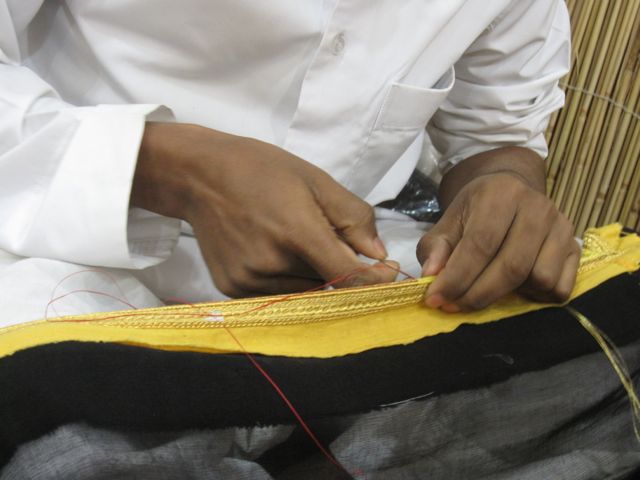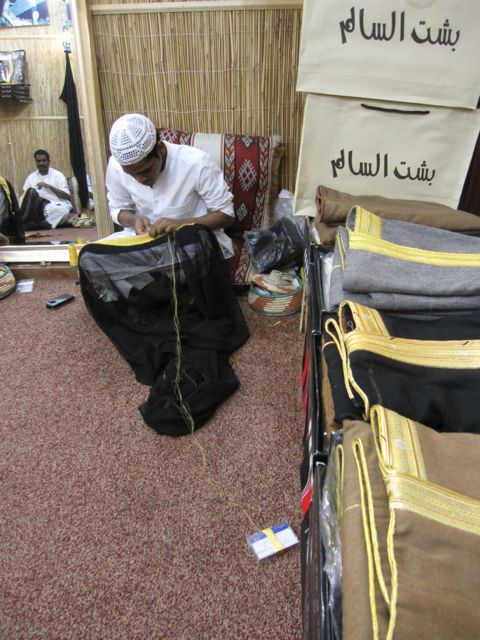The treasures I found on my last trip to Jordan cost only 1 JD each, and had the theme of traditional dress.
First, a brilliant subversion of the Barbie aesthetic, hand crafted by an anonymous woman in Madaba. I saw this display on the street, and was completely enthralled. As I closely examined the whole array, a man told me they were one dinar, and that his wife made the clothing.
I can still look at this photo for ages: such well-dressed women! The various cross stitch, brocade, and print fabrics are so well selected, and the combination of semi-veiled, fully veiled and headband wear makes it look like a parade of actual Jordanian women. And even the occasional man, with a drawn-on beard!
Some of them have black eyes, made with the same pen as the men's beards, and others are left blue-eyed. It's the variety that gets me, and makes such a strong and positive point. The Madaba woman is not simply saying that women should be "modest" or "covered", or that they should all look the same, but saying rather, "Look how lovely we are, in the rich mix of clothing that shows we are Jordanian!"
I only bought the one shown here, after much agonizing over colors and styles. Probably should have gotten at least half a dozen, but sometimes reason does prevail over my collecting urges, supported this time by an imminent international move. I told the man to tell his wife "Mashallah!" - Well done!
It's striking to compare the beauty of these dolls with the images they were originally meant to represent, which I don't see as "beauty" at all, merely convention. Keeping them in the original boxes makes the subversion complete.
I'm definitely a biased observer, given my love for handcrafted clothing and textiles, but to me it's quite obvious which presentation celebrates female identity and beauty more effectively. One has only to imagine all the dolls looking identical, prior to their transformation.
I should also mention that one sees colorful, embroidered robes for sale in the shops, and women really do wear them. Jordanian women are quite visible, active, and professional around town, while maintaining a high level of modesty and coverage with their dress.
The second treasure of this trip was a set of postcards, two for 1 JD, from the Shrine of the Beheading of John the Baptist at Madaba (I know - whoa.) The church is an active one, with evidence of the Orthodox Easter celebrations still scattered around (I was there in April,) and in addition to the interesting architecture and historical aspects of the building, they had a collection of old photographs on display. The prints showed Christians from Kerak and other neighboring areas, who came to Madaba to consolidate the Christian community, around 1900. Of interest to me was, of course, how they dressed.
I noticed the girls were wearing oversized dresses with long, pointed sleeve openings. This was particularly evident on the smaller girls.
You can see that the ends of her sleeves hang in front, and that the dress is bunched up below the waist. This may be less obvious if one has never seen a traditional oversized dress, but I immediately thought of the three meter dress I'd seen at Tiraz, during the textile conference last year.
We had all been fascinated by this dress, and wondering how it was worn, and had found some references in books that showed the belting, blousing of fully half of the length of the dress over the belt, and wrapping or tying of sleeves around, behind, etc. Then someone found an excellent documentary video in Widad Kawar's archives, with a woman demonstrating the belting and arrangement of the extra large dress.
This made me happy to see real examples of such a garment from the early 20th century, and especially happy that the church sold postcards of some of the old photos.
(The photos, from which I have excerpted bits with bad snaps, are credited to R. Savignac and A. Jaussen, and are shown in Madaba courtesy of the École Biblique et Archéologique Française in Jerusalem.)





